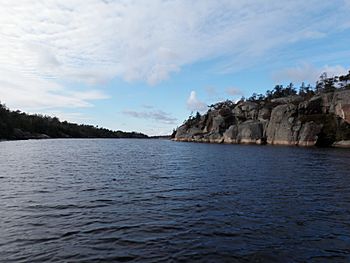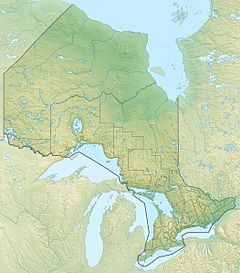Key River facts for kids
Quick facts for kids Key River |
|
|---|---|

Key River west of Highway 69
|
|
|
Location of the mouth of the Key River in Ontario
|
|
| Country | Canada |
| Province | Ontario |
| Region | Parry Sound |
| Physical characteristics | |
| Main source | Portage Lake Parry Sound District 45°54′08″N 80°33′12″W / 45.90222°N 80.55333°W |
| River mouth | Georgian Bay Parry Sound District 45°53′20″N 80°44′01″W / 45.88889°N 80.73361°W |
| Length | 16 km (9.9 mi) |
The Key River is a short river in Ontario, Canada. It flows about 16 kilometres (9.9 mi) from Portage Lake in the east. It ends at Key Harbour in Georgian Bay, which is part of Lake Huron.
This river is a great way for people to reach the northeastern part of Georgian Bay. Many visitors, including those who love fishing, cottagers, and canoeists, use the river. It's easily reached from Ontario Highway 69. The northern side of the river is mostly bordered by the French River Provincial Park. The southern side is next to the Henvey Inlet First Nation Reserve.
Contents
River's Location and Landscape
The Key River flows through an area called the Canadian Shield. This region has very old, hard rock. You can see rugged rock cliffs and outcrops that were shaped by glaciers long ago. The soil in these areas is often thin. There are also parts with marshy, low-lying lands.
A Look at Key River's Past
Early Inhabitants and Treaties
For a very long time, the Anishinaabe Ojibway people lived in this part of the Great Lakes. In 1850, they signed an important agreement. This was the Robinson-Huron Treaty with the British crown. This treaty helped create the Henvey Inlet First Nation Reserve number 2. This reserve is located along the southern shore of the Key River.
The Railway and Industry
Starting in 1907, a railway line was built to Key Harbour. This connected the harbour to an iron ore mine near Sudbury. Large docks and a power station were built at Key Harbour. These were used to unload iron ore from trains onto big freighter ships. The ships would then take the ore to different markets. However, this business didn't last long. The last iron ore was shipped in 1916.
Later, from 1929 to 1938, coal was unloaded at Key Harbour. This coal was for the Canadian National Railway Company. They built a long dock, about 1,200-foot (370 m), into the harbour for this purpose. But as time went on, the railway line was used less and less. So, in 1960, the railway track to Key Harbour was taken apart.
The 2018 Forest Fire
In 2018, a large wildfire happened in the area. It was called the 2018 Parry Sound forest fire. This fire burned more than a dozen cottages and other buildings. It also destroyed about 11,000 hectares (27,000 acres) of forest. The fire affected areas both north and south of the Key River.
Wildlife and Nature
The Key River area is mostly untouched by human development. This makes it a great home for many different animals. You can find many types of mammals, reptiles, birds, and fish here.
Mammals and Reptiles
Some common mammals you might see include moose, American mink, and red fox. You might also spot busy Eastern chipmunks.
The area is also home to several reptiles. These include the northern water snake. There are also some threatened species like the massasauga rattlesnake and the fox snake. You might also see snapping turtles and the endangered five-lined skink.
Birds and Fish
Many birds live around the Key River. Common ones are the ring-billed gull, turkey vulture, and ruffed grouse.
If you enjoy fishing, the Key River is a good spot. Anglers often catch fish like northern pike, small-mouth bass, and walleye.
Plants and Trees
The forests around the river have many types of trees and plants. You'll find tall eastern white pine trees and jack pine trees. There are also white birch trees and eastern juniper bushes. You can also find blueberry bushes. The ground is covered with many kinds of moss and lichen. Sadly, much of the forest along the Key River's banks was burned by the 2018 Parry Sound forest fire.


